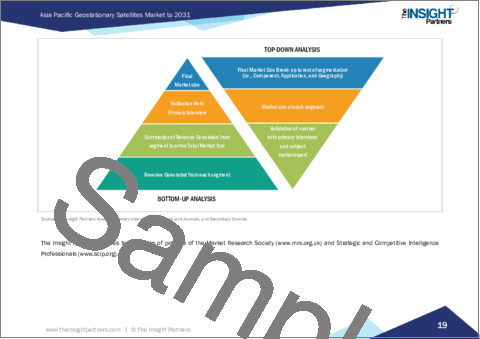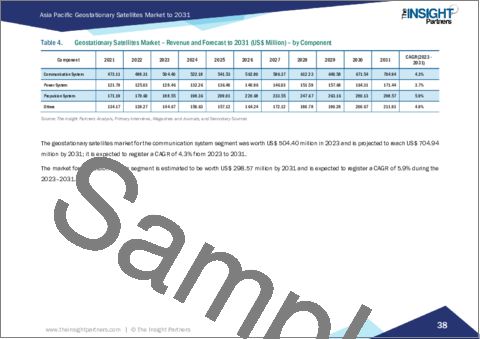|
|
市場調査レポート
商品コード
1715221
アジア太平洋の静止衛星市場:2031年までの予測 - 地域別分析 - コンポーネント別、用途別Asia Pacific Geostationary Satellites Market Forecast to 2031 - Regional Analysis - by Component and Application |
||||||
|
|||||||
| アジア太平洋の静止衛星市場:2031年までの予測 - 地域別分析 - コンポーネント別、用途別 |
|
出版日: 2025年02月11日
発行: The Insight Partners
ページ情報: 英文 133 Pages
納期: 即納可能
|
全表示
- 概要
- 図表
- 目次
アジア太平洋の静止衛星市場は、2023年に9億6,608万米ドルと評価され、2031年までには13億8,687万米ドルに達すると予測され、2023年から2031年までのCAGRは4.6%と推定されます。
静止軌道向け小型衛星の開発がアジア太平洋の静止衛星市場を後押し
Maxar Space Systems、Astranis、Terran Orbital、SWISSto12、Saturn Satellite Networkなどの衛星メーカーは、すでに静止軌道に投入可能な小型衛星の開発に注力しています。これにより、衛星運用会社や打上げ会社は、サイズ、重量、製造コストを抑えた衛星をGEO軌道に投入するための運用コストを削減でき、さらに安心できます。SATELLITE 2020の会期中、複数の衛星会社が、小型衛星専用のロケットで打ち上げられる静止軌道用の小型衛星コンステレーションの開発に注力していることを発表しました。静止軌道への配備を目的とした小型衛星の開発は、今後数年間、市場ベンダーに新たな機会をもたらす可能性が高いです。
アジア太平洋の静止衛星市場概要
アジア太平洋の静止衛星市場の成長は、衛星ベースのナビゲーション、通信、およびいくつかのリモートセンシングアプリケーションを改善するためのニーズの増加に起因しています。中国、インド、オーストラリア、日本は衛星打ち上げに力を入れています。アジア太平洋の静止衛星市場の主要企業には、Neumann、Beijing Spacecraft Manufacturing Co., Ltd、China Aerospace Science Technology Corporation、Kongtian Dongliなどがあります。これらの企業は、宇宙技術の進歩に貢献する取り組みで有名です。2024年3月、Thaicom Satellite TelecommunicationsはAstranisに小型静止衛星Thaicom-9を発注し、2025年に静止軌道に投入する予定です。AstranisとSpace Tech Innovation Limited(Thaicomの子会社)との契約の一環として、ThaicomはAstranisのMicroGEO衛星を配備し、アジアにKaバンドサービスを提供します。この新しい衛星はまた、アジアの最も遠隔で接続されていない地域でブロードバンド接続を提供する可能性があります。
アジア太平洋の静止衛星市場収益と2031年までの予測(金額)
アジア太平洋の静止衛星市場セグメンテーション
アジア太平洋の静止衛星市場は、コンポーネント、用途、および国に分類されます。
コンポーネントに基づき、アジア太平洋の静止衛星市場は通信システム、電力システム、推進システム、その他に区分されます。通信システムセグメントが2023年に最大の市場シェアを占めています。
用途別では、アジア太平洋の静止衛星市場は通信、宇宙探査、ナビゲーション、地球観測、その他に分類されます。2023年には通信分野が最大の市場シェアを占めました。
国別では、アジア太平洋の静止衛星市場は中国、インド、日本、韓国、その他アジア太平洋に区分されます。2023年のアジア太平洋の静止衛星市場シェアは中国が独占しました。
Airbus SE、Ball Corp、Israel Aerospace Industries Ltd、Korea Aerospace Industries Ltd、Lockheed Martin Corp、Northrop Grumman Corp、Thales SA、The Boeing Coは、アジア太平洋の静止衛星市場で事業を展開している主要企業です。
目次
第1章 イントロダクション
第2章 エグゼクティブサマリー
- 主要洞察
- 市場の魅力
第3章 調査手法
- 2次調査
- 1次調査
- 仮説の策定
- マクロ経済要因分析
- ファンデーション数値の開発
- データの三角測量
- 国レベルのデータ
第4章 アジア太平洋の静止衛星市場情勢
- ポーターのファイブフォース分析
- エコシステム分析
- 衛星コンポーネントメーカー
- 静止衛星メーカー
- エンドユーザー
- 静止衛星システムプロバイダー一覧
第5章 アジア太平洋の静止衛星市場:主要市場力学
- アジア太平洋の静止衛星市場:主要市場力学
- 市場促進要因
- 衛星ネットワークによる長距離通信への需要の高まり
- 衛星ベースの軍事通信に対するニーズの高まり
- 市場抑制要因
- 静止衛星の故障事故と受注量の減少
- 市場機会
- 静止軌道向け小型衛星の開発
- 今後の動向
- ソフトウェア定義電気システムの展開
- 促進要因と抑制要因の影響
第6章 静止衛星市場:アジア太平洋の市場分析
- アジア太平洋の概要
- 静止衛星市場の収益、2021年~2031年
- 静止衛星市場の予測分析
第7章 アジア太平洋の静止衛星市場分析-コンポーネント別
- 通信システム
- 電力システム
- 推進システム
- その他
第8章 アジア太平洋の静止衛星市場分析-用途別
- 通信
- 宇宙探査
- ナビゲーション
- 地球観測
- その他
第9章 アジア太平洋の静止衛星市場:国別分析
- アジア太平洋の概要
- アジア太平洋
- 中国
- インド
- 日本
- 韓国
- その他アジア太平洋
第10章 競合情勢
- 企業のポジショニングと集中度
第11章 業界情勢
- 市場イニシアティブ
- 製品開発
第12章 企業プロファイル
- Airbus SE
- The Boeing Co
- Ball Corp
- Korea Aerospace Industries Ltd.
- Lockheed Martin Corp
- Northrop Grumman Corp
- Thales SA
- Israel Aerospace Industries Ltd
第13章 付録
List Of Tables
- Table 1. Geostationary Satellites Market Segmentation
- Table 2. List of Vendors in Value Chain
- Table 3. Geostationary Satellites Market - Revenue and Forecast to 2031 (US$ Million)
- Table 4. Geostationary Satellites Market - Revenue and Forecast to 2031 (US$ Million) - by Component
- Table 5. Geostationary Satellites Market - Revenue and Forecast to 2031 (US$ Million) - by Application
- Table 6. Asia Pacific: Geostationary Satellites Market - Revenue and Forecast to 2031(US$ Million) - by Country
- Table 7. China: Geostationary Satellites Market - Revenue and Forecast to 2031(US$ Million) - by Component
- Table 8. China: Geostationary Satellites Market - Revenue and Forecast to 2031(US$ Million) - by Application
- Table 9. India: Geostationary Satellites Market - Revenue and Forecast to 2031(US$ Million) - by Component
- Table 10. India: Geostationary Satellites Market - Revenue and Forecast to 2031(US$ Million) - by Application
- Table 11. Japan: Geostationary Satellites Market - Revenue and Forecast to 2031(US$ Million) - by Component
- Table 12. Japan: Geostationary Satellites Market - Revenue and Forecast to 2031(US$ Million) - by Application
- Table 13. South Korea: Geostationary Satellites Market - Revenue and Forecast to 2031(US$ Million) - by Component
- Table 14. South Korea: Geostationary Satellites Market - Revenue and Forecast to 2031(US$ Million) - by Application
- Table 15. Rest of Asia Pacific: Geostationary Satellites Market - Revenue and Forecast to 2031(US$ Million) - by Component
- Table 16. Rest of Asia Pacific: Geostationary Satellites Market - Revenue and Forecast to 2031(US$ Million) - by Application
List Of Figures
- Figure 1. Geostationary Satellites Market Segmentation, by Country
- Figure 2. Porter's Five Forces Analysis
- Figure 3. Impact Analysis of Drivers and Restraints
- Figure 4. Geostationary Satellites Market Revenue (US$ Million), 2021-2031
- Figure 5. Geostationary Satellites Market Share (%) - by Component (2023 and 2031)
- Figure 6. Communication System: Geostationary Satellites Market - Revenue and Forecast to 2031 (US$ Million)
- Figure 7. Power System: Geostationary Satellites Market - Revenue and Forecast to 2031 (US$ Million)
- Figure 8. Propulsion System: Geostationary Satellites Market - Revenue and Forecast to 2031 (US$ Million)
- Figure 9. Others: Geostationary Satellites Market - Revenue and Forecast to 2031 (US$ Million)
- Figure 10. Geostationary Satellites Market Share (%) - by Application (2023 and 2031)
- Figure 11. Communications: Geostationary Satellites Market - Revenue and Forecast to 2031 (US$ Million)
- Figure 12. Space Exploration: Geostationary Satellites Market - Revenue and Forecast to 2031 (US$ Million)
- Figure 13. Navigation: Geostationary Satellites Market - Revenue and Forecast to 2031 (US$ Million)
- Figure 14. Earth Observation: Geostationary Satellites Market - Revenue and Forecast to 2031 (US$ Million)
- Figure 15. Others: Geostationary Satellites Market - Revenue and Forecast to 2031 (US$ Million)
- Figure 16. Asia Pacific Geostationary Satellites Market, by Key Countries- Revenue (2023) (US$ Million)
- Figure 17. Asia Pacific Geostationary Satellites Market Breakdown, by Key Countries, 2023 and 2031 (%)
- Figure 18. China: Geostationary Satellites Market - Revenue and Forecast to 2031(US$ Million)
- Figure 19. India: Geostationary Satellites Market - Revenue and Forecast to 2031(US$ Million)
- Figure 20. Japan: Geostationary Satellites Market - Revenue and Forecast to 2031(US$ Million)
- Figure 21. South Korea: Geostationary Satellites Market - Revenue and Forecast to 2031(US$ Million)
- Figure 22. Rest of Asia Pacific: Geostationary Satellites Market - Revenue and Forecast to 2031(US$ Million)
- Figure 23. Company Positioning & Concentration
The Asia Pacific geostationary satellites market was valued at US$ 966.08 million in 2023 and is anticipated to reach US$ 1,386.87 million by 2031; it is estimated to register a CAGR of 4.6% from 2023 to 2031.
Development of Small Satellites for Geostationary Orbit Boosts Asia Pacific Geostationary Satellites Market
Satellite manufacturers such as Maxar Space Systems, Astranis, Terran Orbital, SWISSto12, and Saturn Satellite Network have already been focusing on the development of small satellites that can be deployed into the GEO orbit. This will further provide relief to the satellite operators and launch companies, reducing their operational costs for placing a satellite into the GEO orbit with lesser size, weight, and cost of manufacturing. During the conference of" SATELLITE 2020," several satellite companies announced that they have been focusing on the development of smallsat constellations for geostationary orbits that can be deployed through small satellite-specialized launch vehicles, which will ultimately reduce the overall cost of satellite launches and orbit placement of satellites into the GEO orbits. The development of small satellites for deployment into geostationary orbit is likely to generate new opportunities for market vendors in the coming years.
Asia Pacific Geostationary Satellites Market Overview
The Asia Pacific geostationary satellite market growth is attributed to the increasing need for improving satellite-based navigation, communication, and several remote sensing applications. China, India, Australia and Japan have a strong focus on the launch of satellites. Key players in the geostationary satellite market in Asia Pacific include Neumann; Beijing Spacecraft Manufacturing Co., Ltd; China Aerospace Science Technology Corporation; and Kongtian Dongli. These companies are renowned for their initiatives to contribute to the progress of space technology. In March 2024, Thaicom Satellite Telecommunications ordered a small geostationary satellite from Astranis-Thaicom-9-which is scheduled for launch in geostationary orbit in 2025. As part of the agreement between Astranis and Space Tech Innovation Limited (Thaicom's subsidiary), Thaicom would deploy the Astranis MicroGEO satellite to provide Ka-band services over Asia. The new satellite is also likely to provide broadband connectivity in the most remote and unconnected areas in Asia.
Asia Pacific Geostationary Satellites Market Revenue and Forecast to 2031 (US$ Million)
Asia Pacific Geostationary Satellites Market Segmentation
The Asia Pacific geostationary satellites market is categorized into component, application, and country.
Based on component, the Asia Pacific geostationary satellites market is segmented into communication system, power system, propulsion system, and others. The communication system segment held the largest market share in 2023.
In terms of application, the Asia Pacific geostationary satellites market is categorized into communications, space exploration, navigation, earth observation, and others. The communications segment held the largest market share in 2023.
By country, the Asia Pacific geostationary satellites market is segmented into China, India, Japan, South Korea, and the Rest of Asia Pacific. China dominated the Asia Pacific geostationary satellites market share in 2023.
Airbus SE, Ball Corp, Israel Aerospace Industries Ltd, Korea Aerospace Industries Ltd., Lockheed Martin Corp, Northrop Grumman Corp, Thales SA, and The Boeing Co are some of the leading companies operating in the Asia Pacific geostationary satellites market.
Table Of Contents
1. Introduction
- 1.1 The Insight Partners Research Report Guidance
- 1.2 Market Segmentation
2. Executive Summary
- 2.1 Key Insights
- 2.2 Market Attractiveness
3. Research Methodology
- 3.1 Secondary Research
- 3.2 Primary Research
- 3.2.1 Hypothesis formulation:
- 3.2.2 Macro-economic factor analysis:
- 3.2.3 Developing base number:
- 3.2.4 Data Triangulation:
- 3.2.5 Country level data:
4. Asia Pacific Geostationary Satellites Market Landscape
- 4.1 Overview
- 4.2 Porter's Five Forces Analysis
- 4.3 Ecosystem Analysis
- 4.3.1 Satellite Component Manufacturers:
- 4.3.2 Geostationary Satellite Manufacturers:
- 4.3.3 End Users:
- 4.3.4 List of Geostationary Satellite System Providers
5. Asia Pacific Geostationary Satellites Market - Key Market Dynamics
- 5.1 Asia Pacific Geostationary Satellites Market - Key Market Dynamics
- 5.2 Market Drivers
- 5.2.1 Increasing Demand for Long-Range Communication Coverage Through Satellite Network
- 5.2.2 Growing Need for Satellite-Based Military Communications
- 5.3 Market Restraints
- 5.3.1 Incidents of Geostationary Satellite Failures and Decline in Orders of Geostationary Satellites
- 5.4 Market Opportunities
- 5.4.1 Development of Small Satellites for Geostationary Orbit
- 5.5 Future Trends
- 5.5.1 Deployment of Software-Defined Electric Systems
- 5.6 Impact of Drivers and Restraints:
6. Geostationary Satellites Market - Asia Pacific Market Analysis
- 6.1 Asia Pacific Overview
- 6.2 Geostationary Satellites Market Revenue (US$ Million), 2021-2031
- 6.3 Geostationary Satellites Market Forecast Analysis
7. Asia Pacific Geostationary Satellites Market Analysis - by Component
- 7.1 Communication System
- 7.1.1 Overview
- 7.1.2 Communication System: Geostationary Satellites Market - Revenue and Forecast to 2031 (US$ Million)
- 7.2 Power System
- 7.2.1 Overview
- 7.2.2 Power System: Geostationary Satellites Market - Revenue and Forecast to 2031 (US$ Million)
- 7.3 Propulsion System
- 7.3.1 Overview
- 7.3.2 Propulsion System: Geostationary Satellites Market - Revenue and Forecast to 2031 (US$ Million)
- 7.4 Others
- 7.4.1 Overview
- 7.4.2 Others: Geostationary Satellites Market - Revenue and Forecast to 2031 (US$ Million)
8. Asia Pacific Geostationary Satellites Market Analysis - by Application
- 8.1 Communications
- 8.1.1 Overview
- 8.1.2 Communications: Geostationary Satellites Market - Revenue and Forecast to 2031 (US$ Million)
- 8.2 Space Exploration
- 8.2.1 Overview
- 8.2.2 Space Exploration: Geostationary Satellites Market - Revenue and Forecast to 2031 (US$ Million)
- 8.3 Navigation
- 8.3.1 Overview
- 8.3.2 Navigation: Geostationary Satellites Market - Revenue and Forecast to 2031 (US$ Million)
- 8.4 Earth Observation
- 8.4.1 Overview
- 8.4.2 Earth Observation: Geostationary Satellites Market - Revenue and Forecast to 2031 (US$ Million)
- 8.5 Others
- 8.5.1 Overview
- 8.5.2 Others: Geostationary Satellites Market - Revenue and Forecast to 2031 (US$ Million)
9. Asia Pacific Geostationary Satellites Market - Country Analysis
- 9.1 Overview Asia Pacific
- 9.1.1 Asia Pacific Geostationary Satellites Market, by Key Countries - Revenue (2023) (US$ Million)
- 9.1.2 Asia Pacific Geostationary Satellites Market - Revenue and Forecast Analysis - by Country
- 9.1.2.1 Asia Pacific: Geostationary Satellites Market - Revenue and Forecast Analysis - by Country
- 9.1.2.2 China: Geostationary Satellites Market - Revenue and Forecast to 2031 (US$ Million)
- 9.1.2.2.1 China: Geostationary Satellites Market Breakdown, by Component
- 9.1.2.2.2 China: Geostationary Satellites Market Breakdown, by Application
- 9.1.2.3 India: Geostationary Satellites Market - Revenue and Forecast to 2031 (US$ Million)
- 9.1.2.3.1 India: Geostationary Satellites Market Breakdown, by Component
- 9.1.2.3.2 India: Geostationary Satellites Market Breakdown, by Application
- 9.1.2.4 Japan: Geostationary Satellites Market - Revenue and Forecast to 2031 (US$ Million)
- 9.1.2.4.1 Japan: Geostationary Satellites Market Breakdown, by Component
- 9.1.2.4.2 Japan: Geostationary Satellites Market Breakdown, by Application
- 9.1.2.5 South Korea: Geostationary Satellites Market - Revenue and Forecast to 2031 (US$ Million)
- 9.1.2.5.1 South Korea: Geostationary Satellites Market Breakdown, by Component
- 9.1.2.5.2 South Korea: Geostationary Satellites Market Breakdown, by Application
- 9.1.2.6 Rest of Asia Pacific: Geostationary Satellites Market - Revenue and Forecast to 2031 (US$ Million)
- 9.1.2.6.1 Rest of Asia Pacific: Geostationary Satellites Market Breakdown, by Component
- 9.1.2.6.2 Rest of Asia Pacific: Geostationary Satellites Market Breakdown, by Application
10. Competitive Landscape
- 10.1 Company Positioning & Concentration
11. Industry Landscape
- 11.1 Overview
- 11.2 Market Initiative
- 11.3 Product Development
12. Company Profiles
- 12.1 Airbus SE
- 12.1.1 Key Facts
- 12.1.2 Business Description
- 12.1.3 Products and Services
- 12.1.4 Financial Overview
- 12.1.5 SWOT Analysis
- 12.1.6 Key Developments
- 12.2 The Boeing Co
- 12.2.1 Key Facts
- 12.2.2 Business Description
- 12.2.3 Products and Services
- 12.2.4 Financial Overview
- 12.2.5 SWOT Analysis
- 12.2.6 Key Developments
- 12.3 Ball Corp
- 12.3.1 Key Facts
- 12.3.2 Business Description
- 12.3.3 Products and Services
- 12.3.4 Financial Overview
- 12.3.5 SWOT Analysis
- 12.3.6 Key Developments
- 12.4 Korea Aerospace Industries Ltd.
- 12.4.1 Key Facts
- 12.4.2 Business Description
- 12.4.3 Products and Services
- 12.4.4 Financial Overview
- 12.4.5 SWOT Analysis
- 12.4.6 Key Developments
- 12.5 Lockheed Martin Corp
- 12.5.1 Key Facts
- 12.5.2 Business Description
- 12.5.3 Products and Services
- 12.5.4 Financial Overview
- 12.5.5 SWOT Analysis
- 12.5.6 Key Developments
- 12.6 Northrop Grumman Corp
- 12.6.1 Key Facts
- 12.6.2 Business Description
- 12.6.3 Products and Services
- 12.6.4 Financial Overview
- 12.6.5 SWOT Analysis
- 12.6.6 Key Developments
- 12.7 Thales SA
- 12.7.1 Key Facts
- 12.7.2 Business Description
- 12.7.3 Products and Services
- 12.7.4 Financial Overview
- 12.7.5 SWOT Analysis
- 12.7.6 Key Developments
- 12.8 Israel Aerospace Industries Ltd
- 12.8.1 Key Facts
- 12.8.2 Business Description
- 12.8.3 Products and Services
- 12.8.4 Financial Overview
- 12.8.5 SWOT Analysis
- 12.8.6 Key Developments
13. Appendix
- 13.1 About The Insight Partners






